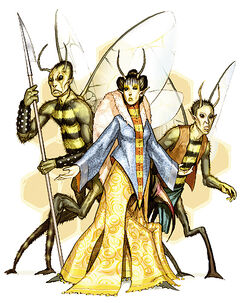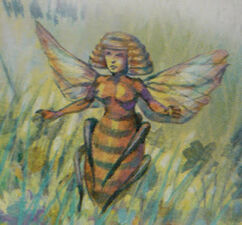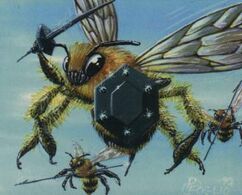Origins[]
The Bee-Person has roots in the mythology, legend and folklore of many cultures around the world. It has been mentioned in numerous roles, most predominantly in accounts of shamanism, animism and the occult.
In North America, there exist visible accounts in Mexico, among the Huichol/Wixáritari Native American tribes. In particular, there is a myth about how the first beeswax came into existence. One day, the sea-gods were unable to light their candles. A spirit called 'Grandfather Fire' suggested that the sea-gods send out emissaries to visit the female spirit Waweme, who was responsible for the candle's flame (among other things).
Only one of the three emissaries remained faithful and made it to Waweme (the other two got frustrated and discouraged).

"All hail venerable Queen Melissa Regina Bea!"
Waweme manifested herself to that boy, and taught him the secrets of shamanism, including how to turn into a bee and how to gather sacred honey, worthy of Waweme. A jealous encounter with his former fellow emissaries, and upon his death, his burning body produces beeswax for the sea-gods' candles.
In South America, there exist accounts in Venezuela, among the Warao native tribes. In particular, there is a tale about the legendary first shaman of their tribe. A youth went on a spirit journey to gain the shamanistic knowledge of Mawari, a Warao ancestor spirit. After proving himself wise to Mawari, and gaining the spirit's knowledge, he returned from his journey, and began meditating on his new-found shamanic knowledge.
His four-day-long meditation attracted four tribes of insectoid spirits (Wasp, Blue Bee, Black Bee and Termite People), who were companions of Mawari. On the fifth day, he reached a state of consciousness where he could channel a spirit from one of each of the four tribes. He then took a wife from one of the Bee tribes, and copulated with her to father the four spirits that he had channeled, to be born as human sons.

"Seize the intruders!"
In Southeast Asia and Oceania, there exist accounts in Thailand, among the Akha tribe, and in Borneo, Indonesia. In particular, there exists an Indonesian tale of a man named Rakian who marries a bee-woman, under the condition that he would not reveal her true nature to others in their village. One night, however, he did mistakenly reveal his wife for a bee-woman, after getting drunk with friends.
Upon finding out her secret had been revealed, the bee-woman ran away back to her home hive. Rakian sought her out for weeks, and upon finding her, he made amends with his wife and her hive of bee-people. They accepted Rakian's apology, and allowed him to live among their ranks for the rest of his days, along with the children that he and his bee-wife would later have.
In Europe, there exist accounts in Ancient Greek myth, as well as Celtic mysticism (though, some speculate that the Greek "bee-woman" may simply be an archetypal metaphor for a hard-working, faithful wife).
Other examples of bee-people likely exist in mythology, but these are among more famous, well-known accounts. Though, it is unknown (only assumed) that these and other tales refer to the same type of bee-humanoid creature.

Appearance[]
As the name of the species implies, a Bee Person often resembles a mix of human(oid) traits, and the traits of a bee.
The presence and combination of antennae, extra limbs, wings, a stinger, bee coloration and/or other bee body parts varies from each breed, and even among individuals, due to their nature as shapeshifters.
Behavior[]
A Bee-Person is rarely ever alone. That is not to say that they are clingy or codependent, but they have a strong sense of family, community and duty to others. In the cause of the greater good, they are the ones to call.
In the same vein, they make for diligent workers, in any field of work to which they are assigned. They make humble, loyal servants and persistent, dutiful soldiers. They are obedient, dedicated and strong-willed in the service of the one in power.
In opposing an enemy, they are equally strong-willed, if not more so. The cause they serve is held above all. The leader they serve (most often a Queen Bee) sets out the dictate of their personal philosophy, and the Hive defends it ruthlessly.
If the Bee People's leader were to have a sudden change of philosophy, it becomes a change to the entire Hive's philosophy, without barely second thought. All previous trains of thought are re-framed in terms of the new dictate. A Bee Person's ego is more strongly tied to the Hive and/or its leader than ever to themselves.

"So...what's the buzz?"
Though, typically, the philosophies that change pertain only to how the Bee People deal with outsiders. As per their nature, the genetically-predisposed Queen is surrounded by Drones (males designated for the primary purpose of mating with the Queen) and the hard work is left to the Workers (females, which are often primarily infertile).
Rare is the occasion when there is no work for a Bee Person to do, regardless of what station they hold in society (except, of course, the growing Larvae, which are too young and weak to do work). Though, while the Bee People remain constantly busy, the day is kept going with meals of nectar and pollen. And entertainment often arrives for the Hive in the form of Workers' wiggle dances (which help give directions to more sources of flowers to pollinate).
Due to the important roles of pollen, nectar, honey, royal jelly, beeswax and similar substances in Bee People society, they are particularly cautious when venturing into the worlds of humans and other humanoids. The supply is simply too easy to cut off, outside of their own native lands.

"Steal OUR honey, will you?"
And so, as they venture out into new lands, they often find it best to remain in small insect mien. This allows teeming populations of Bee People to get more sustenance from smaller supplies of food, while also preventing the natives of that land from getting restless about the sudden imposition of the Bee People on their way of life.
Abilities[]
Bee People are born shapeshifters. They are capable of taking on forms with various mixtures of human(oid) and bee attributes. In addition, many can transition between traits from more than one type of bee species at a time. They can take on the shape of an ordinary bee, a bee the size of a baseline human(oid), a human(oid) the size of a bee (similar to a fairy or pixie) and the like.
In addition to this, while both male and female Bee People are capable of producing stingers, only females possess true natural stingers, capable of delivering venom.
A trait that all Bee People share, however, is power within their wings. Depending on the speed and rhythm that a Bee Person beats their wings, they can produce a number of sonic effects. This may range from a mid-level sonic blast, to inducing sleep, to even inducing a hypnotic trance.
Not to mention, even in humanoid mien, they maintain the ability to communicate with bees (and often other insects), as well as the ability to scale walls, if the need should arise.
Weaknesses[]
While Bee People possess remarkable powers of shapeshifting

